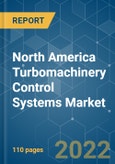The North American turbomachinery control systems market is expected to witness a CAGR of more than 5% during the forecast period, 2022-2027. The COVID-19 pandemic led to various projects being delayed due to the economic slowdown and financial losses incurred to the companies in 2020. The oil and gas projects have been majorly affected due to the high financial burden on the operator amid the fluctuating oil prices resulting from the lower demand. Factors such as shifting from conventional fuel-based power generation to gas-based power generation and increasing shift in focus toward natural gas are expected to drive the demand for turbomachinery control systems in North America during the forecast period. However, the increasing prominence of renewable energy sources is expected to restrain the growth of the market during the forecast period.
The North American turbomachinery control systems market is moderately fragmented. The key players in the market include ABB Ltd, Emerson Electric Co., Siemens Energy AG, Honeywell International Inc., and Rockwell Automation Inc.
This product will be delivered within 2 business days.
Key Highlights
- The power industry is expected to dominate the turbomachinery control systems market, owing to increasing power generation and consumption in the North American region.
- The advancements in turbomachinery control systems technology with a special focus on gas expansion turbines used in LNG plants are expected to create several opportunities for the market in the coming years.
- The United States is likely to be the largest market for turbomachinery control systems in the North American region during the forecast period.
Key Market Trends
Power Sector to Dominate the Market
- In the power sector, turbomachinery control systems are used in equipment like turbines used for power generation and compressors that are used to provide consistent pressure required for the operation of pneumatic valves and actuators in the power plant. In traditional power generation systems (steam and gas), turbomachinery control systems play an integral part in enhancing the turbomachinery equipment's productivity and safety.
- The demand for electricity is growing at a rapid rate on account of the surge in population and industrial expansion. Apart from that, the increasing investments in the power sector and power consumption that is likely to create huge demand for the expansion of power infrastructure in the near future.
- The use of turbomachinery control systems has gained importance from the fact that conventional power generation technologies are facing increasing challenges from alternate sources of energy in terms of the cost of power generation. The use of turbomachinery control systems leads to efficiency improvement in the power generation process from conventional fuel, which is likely to be a big boost for the market during the forecast period.
- The modernization of the grid to accommodate power flows, serve reliability needs, and meet future projected uses is leading to the incorporation of electronic intelligence capabilities for power control purposes and operations monitoring. The turbomachinery control systems play an essential role in this regard.
- Therefore, owing to the above points, the power segment is expected to dominate the North American turbomachinery control systems market during the forecast period.
United States to Dominate the Market
- The United States is one of the major markets for turbomachinery control systems. The major factors driving the demand are increasing conversion of coal-fired to gas-based power plants and growing unconventional gas exploration and production.
- The United States remains the largest market for funding and commercializing innovative technologies, which already attracts many technology firms engaged in the power (including oil and gas) and chemical industries.
- The US market is driven by the retrofitting of aging power plants, such as coal-fired and gas-fired, by installing control systems to enhance the efficiency of plants, which leads to life extension of aging infrastructure. Also, the development of new natural gas power plants and combined heat and power (CHP) plants are expected to further drive the turbine control systems market in the country.
- The power industry in the United States is expected to witness a big change during the forecast period. Decommissioning of coal-fired plants is likely to pave the way for the adoption of gas-fired plants. Consequently, the transition in the energy mix from coal to natural gas is likely to result in the increasing deployment of gas turbines, thus, increasing the demand for turbine control systems.
- As of 2020, the United States’ generating capacity at natural gas-fired combined-cycle (NGCC) power plants totaled 483 gigawatts (GW), compared to 218 GW at coal-fired power plants. Total capacity for generating power in the United States across all types of natural gas-fired generating technologies surpassed coal as the primary capacity resource more than 15 years ago.
- The country is also witnessing increasing natural gas production. In 2020, the United States gas production was around 88.25 billion cubic feet per day (Bcf/d), which is expected to increase further. Consequently, the increase in production of natural gas is likely to influence the demand for turbomachinery and, similarly, turbomachinery control systems.
- Therefore, owing to the above points, the United States is expected to dominate the turbomachinery control systems market in the North American region during the forecast period.
Competitive Landscape
The North American turbomachinery control systems market is moderately fragmented. The key players in the market include ABB Ltd, Emerson Electric Co., Siemens Energy AG, Honeywell International Inc., and Rockwell Automation Inc.
Additional Benefits:
- The market estimate (ME) sheet in Excel format
- 3 months of analyst support
This product will be delivered within 2 business days.
Table of Contents
1 INTRODUCTION
4 MARKET OVERVIEW
5 MARKET SEGMENTATION
6 COMPETITIVE LANDSCAPE
Companies Mentioned (Partial List)
A selection of companies mentioned in this report includes, but is not limited to:
- ABB Ltd
- Emerson Electric Co.
- Siemens Energy AG
- Honeywell International Inc.
- Rockwell Automation Inc.
- General Electric Company
- Schneider Electric SE
- Hollysys Automation Technologies Ltd
- Yokogawa Electric Corporation
- Control-Care BV










